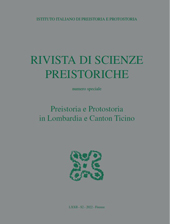Le risorse litiche scheggiabili delle Prealpi della Lombardia centro-orientale : primi dati per una caratterizzazione degli areali di approvvigionamento delle materie prime usate durante la preistoria
P. 217-237
The Lombardian Prealps belong to the Central part of the Southern Alps. Since the lower Jurassic this area, as generally the whole Southalpine, characterizes for an articulated morphology of the substratum, with uplifted elements (platforms, plateaus) and adjacent basins, as a consequence of the rifting and distension (faulting) caused by the opening of the Piedmont-Ligurian Ocean (Alpine Tethys) between the Eurasian and African continental blocks. The study area belongs to the Lombardian Basin which was confined by the Trento (east) and the Canavese (west) plateaus. The sedimentary evolution on the submarine paleo highs and bottom basins followed different dynamics, thus effecting differences in the sedimentary series. Consequently, the siliceous sediments and cherts, which are common in both areas, show different features. Finally, the post-depositional events affected the preservation (erosion) and integrity (local tectonics) of cherts in the different paleo domains.
The Trento Plateau cherts and their outcrops are quite well known as they have been the object of many specific and regional studies during the last twenty years, describing the exceptional petrographic suitability (in terms of lithic technology) of these materials. On the contrary the Lombardian cherts have been poorly studied and they are almost unknown from a petrographic point of view. Most of the literature regarding the Lombardian prehistoric collections considers the Trento Plateau cherts highly represented among the lithic assemblages, even if this evidence has never been supported by specific studies. We can state that the potential value of the eastern Lombardian cherts has certainly been underestimated right now. Our work, linked to detailed research in the region, aims to increase the knowledge on lithic raw materials from Central-Eastern Lombardian Prealps to better understand their exploitation and circulation during the Prehistory.
The lithic industries of some key-sites, from Middle Palaeolithic to Bronze Age have been grouped and classified on the basis of petrographic analysis; the archaeological collections were then compared with the geological samples collected in several field excursions in the Brescia and Bergamo districts. Although our study is still in progress, we consider the achieved results to be very important to outline the chert exploitation dynamics during the Prehistory in the Lombardian area but also in the wider Po-Alpine region. The new data allow to hypothesize both what role the exploitation of local resources could have played in the economy of the sites and what were the criteria of selecting the different materials. In a more general perspective these outcomes provide new insight in order to reconstruct the human groups mobility, to interpret sites function and lithic raw materials procurement, processing, circulation and destination, in a diachronic point of view. [Publisher's text]
-
Artikel aus derselben Ausgabe (einzeln erhältlich)
-
Informationen
DOI: 10.32097/1172
ISSN: 2282-457X
THEMENBEREICHE


